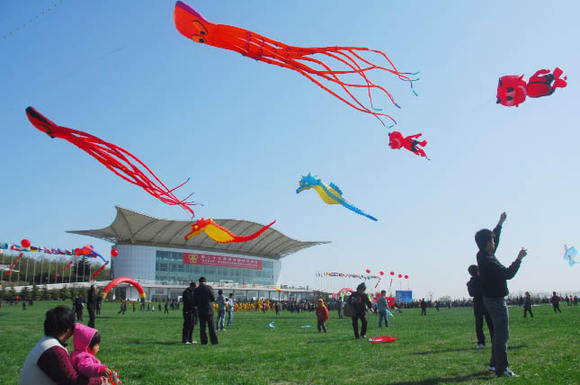| Folklore Flying High in Weifang
By staff reporter JIAO FENG
WEIFANG International Kite Festival is from one angle a renowned folkloric activity in China, and from another, a grand international event in kite folklore. Beginning in 1984, the event has been conducted annually every April in Weifang, Shandong Province on China's east coast. This year is the 28th session of this pageant.
More than any other place Weifang reminds us of kite folklore traditions. The city has a long history of kite making, and is widely admired for its sophisticated workmanship of all the processes involved: framing the bamboo skeleton, pasting it with paper to flesh out a beautiful form, and painting the plain kite in beautiful colors to give it an animated image when the thing flies. All these are done with a know-how to make the kite easy to fly. In the 1950s, Weifang kites were sold on overseas markets, celebrated for flying high in the skies of over 20 foreign countries and regions. On April 1, 1988 the Presidium of the Fifth Weifang International Kite Festival voted Weifang into the "Kite City of the World," and decided to collect the 10 champion kites selected from around the world and house them in the Weifang Kite Museum as permanent souvenirs.
During the annual international kite festival, Weifang hosts a variety of activities for participants to explore other aspects of local folklore and culture besides kite making and flying competitions and craftsmanship exchange. Weifang has healthy highway and railway arteries and airline connection, so while it attracts abundant kite producers and flying enthusiasts, the event also draws regular tourists to do other things besides indulge their curiosity in the myriad of little creatures flying in the colorful sky.
 |
|
The Fuyanshan International Kite Flying Ground in Weifang. |
The History of Kites
The secrets of the true origin of kites and kite flying have been buried by time. Folklore has it that the tradition of kite flying is founded in remembrance of the dead. According to mythology, on Qingming Festival (around April 5, the traditional day of paying homage to the dead), the closed door to the nether world of the dead will open; so people fly kites that they believe will traverse the realms of the dead to send their love and grief over their loss. Another folk belief is that spring is the time of life reawakening; people can release the bad luck and misfortune accumulated during the previous year by flying a kite in spring. Custom requires the string that pulls the kite be cut to let the kite go, and with it go all the bad luck and evil spirits that have harassed the family. So, no one should pick up a fallen kite and all the bad things it carries.
The earliest historical reference to kites in Chinese records is one made from wood. Sometime during the 4th or 5th century B.C., the famous Chinese philosopher Mozi spent three years building a wooden bird, which could stay aloft for a whole day. One of his students, a prestigious master carpenter in Chinese history called Lu Ban, emulated his technique; he cut bamboo into thin sticks, smoothed their surface, and heated them over fire to get the shape he wanted. His finished bamboo bird could fly continuously for three days. This was the prototype of the kite. In the Eastern Han Dynasty, Cai Lun (a.61-121) invented papermaking, and people began to make paper kites; they called them "paper birds."
|
